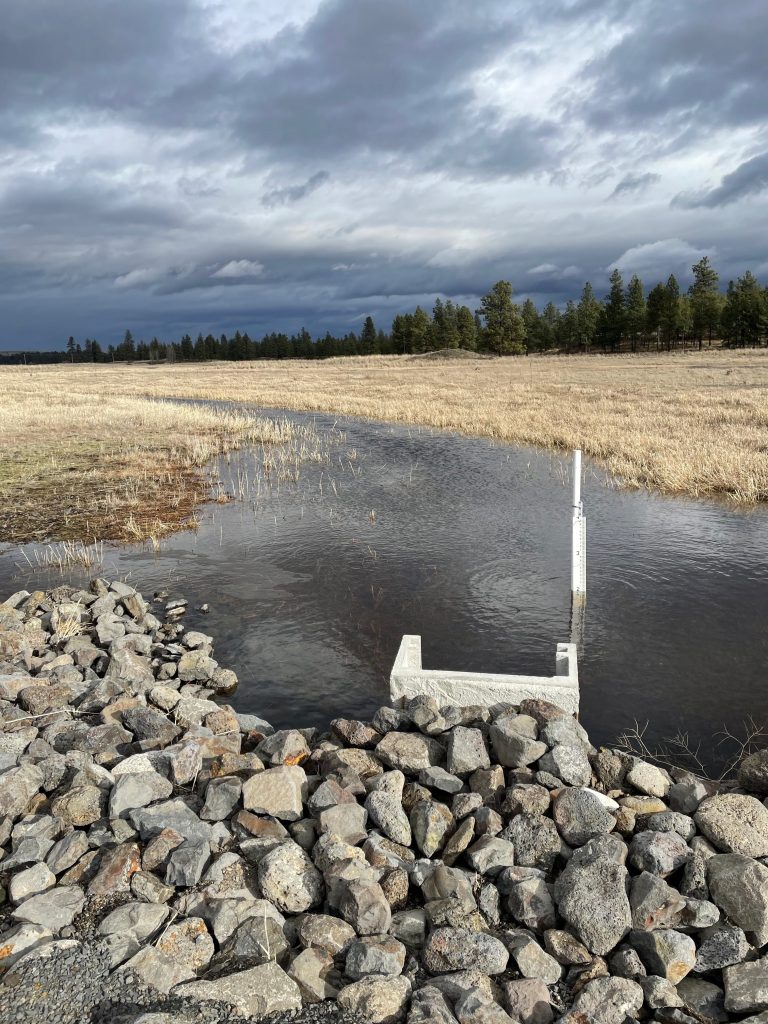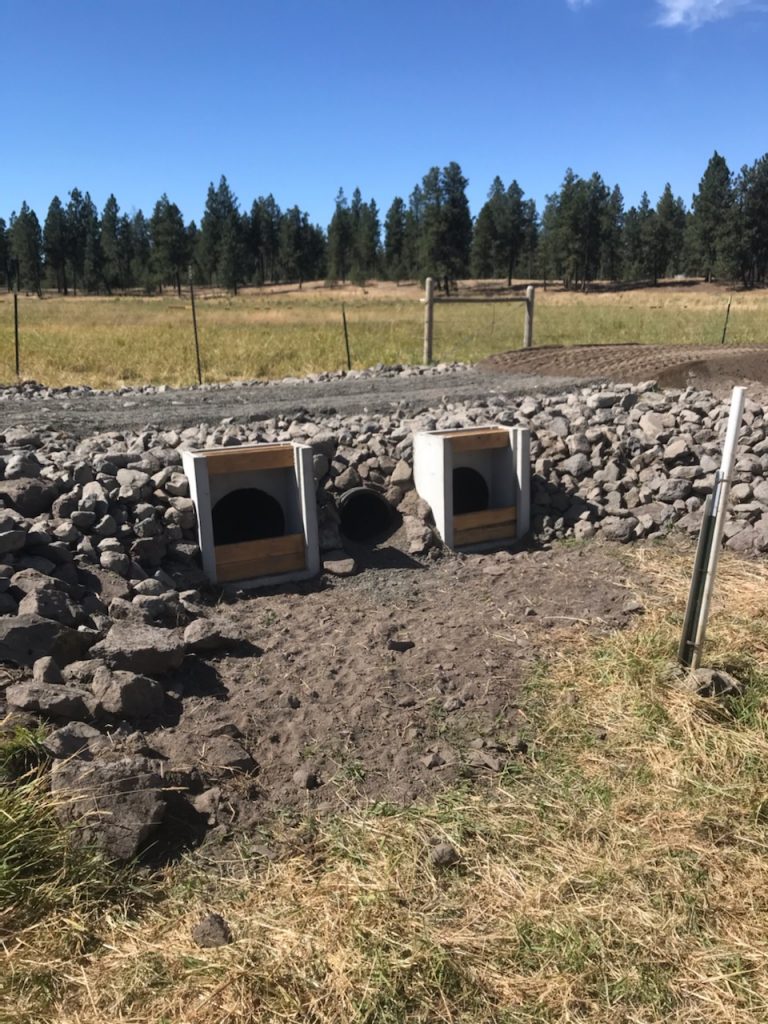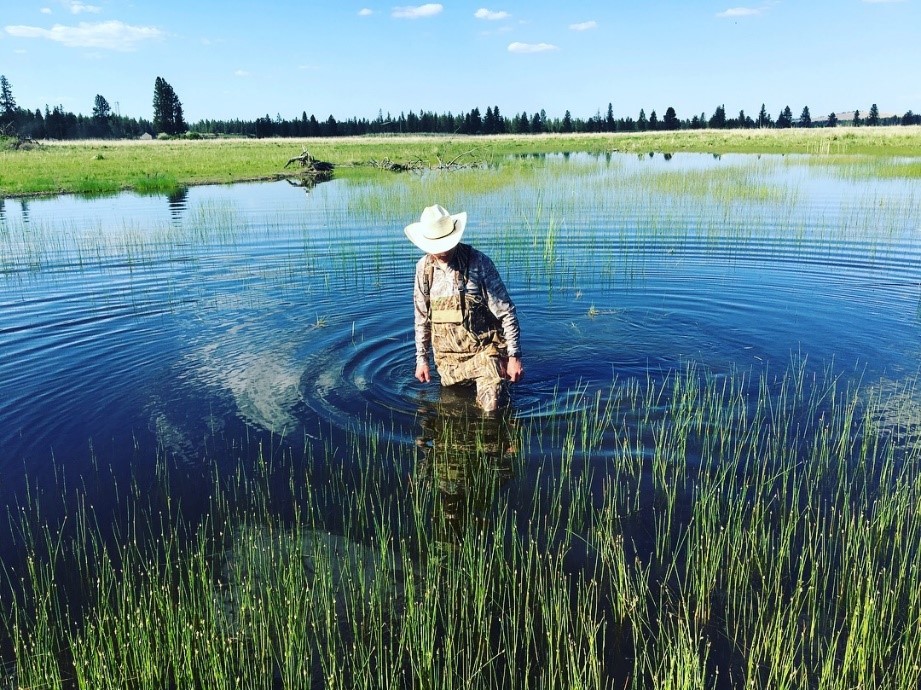Working Wet Meadows: A Low-Tech Waterfowl Stopover in the Channeled Scablands
 Article and photos by Sarah and Trevor Siperek, Meadow Creek Ranch LLC
Article and photos by Sarah and Trevor Siperek, Meadow Creek Ranch LLC
Editor’s Note: Water 4 supports partnership-based conservation tailored to the unique opportunities and needs within landscapes, including conservation easements, agricultural flood irrigation infrastructure enhancements, fish and big game habitat improvement, and water management planning timed to habitat needs. This article features a project on a ranch in Washington’s Channeled Scablands, an important stopover site for migratory waterbirds and waterfowl, that is an excellent example of a low-tech restoration project on private land that results in benefits for bird habitat. Here, Sarah and Trevor share their process as a case study in the power of simple infrastructure improvements that can make a world of difference.
Each spring, Eastern Washington’s Channeled Scablands support an estimated 300,000 waterfowl migrating north in the Pacific Flyway. These birds are drawn to the Channeled Scablands’ unique landscape of long, narrow lakes, potholes, and seasonal wet meadows for critical stopover habitat on their seasonal migration.
Trevor and Sarah Siperek are first-generation ranchers who own and manage a ranch within the Channeled Scablands. The property location falls within one of Intermountain West Joint Venture’s (IWJV) priority Bird Habitat Conservation Areas. In 2010, Ducks Unlimited successfully obtained a permanent conservation easement that protects a portion of the Siperek’s property from future development.
One of the most unique features of the property is the seasonal creek. The creek runs through a large wet meadow that contains riparian wetlands that provide excellent waterfowl habitat. Seasonal flows from the creek are critical to this habitat because the higher water surface elevations in early spring allow water from the creek to charge the adjacent wetland basins and wet meadows on the property.

A view of the creek after improvements were made.
An unimproved road runs perpendicularly across the wet meadow and previously featured two culverts within the creek channel. However, in the past few years, Trevor and Sarah started to notice significant erosion of the farm road due to seasonal high water events. Additionally, the existing culverts were beginning to rust and deteriorate. Through their collaboration with Ducks Unlimited, the Sipereks identified that a culvert crossing failure could result in an 11 percent decrease in water surface elevations, and also risk reducing the ability for the adjacent wetland basins and wet meadows to be recharged each spring.
“We are always trying to find ways that we can be better stewards and caretakers of the land,” said Sarah.
The Sipereks recognized that the failure of their road crossing would not only jeopardize habitat for migratory waterfowl, but could also impact their seasonal grazing and haying operations, activities that are permitted under the terms of the conservation easement and enable the ranch to remain operational.
“We often joke that ‘we ranch for ducks’ because if we have healthy resilient wet meadows and wetlands, then it translates to better forage and hay production for our seasonal cattle grazing operations,” said Trevor.
Recognizing the problem, the Sipereks set out to find a solution to the culvert problem. However, they quickly found out the requirements were quite extensive. Trevor and Sarah placed a significant amount of trust in Ducks Unlimited and turned to the organization for technical support and streamflow data that was essential to the design and the approval of the project.
“We really did not know what we were getting into,” said Sarah. “Over the years we have worked hard to maintain a working partnership with Ducks Unlimited and they were able to provide us the technical information that we needed for this project.”

The finished product: three new culverts, two of which have concrete flashboard risers.
In the fall of 2020, Trevor and Sarah were able to secure the required permits and removed the two old culverts. They chose an updated low-tech and low-cost design that consisted of three new culverts, two of which were fitted with pre-cast concrete flashboard risers. The completed project is estimated to benefit approximately 70 acres of palustrine freshwater emergent wetlands and 25 acres of adjacent grasslands due to improved connectivity to the floodplain. Additionally, the new design includes a smaller culvert that provides unrestricted access for seasonal fish passage and should provide an estimated 45 percent reduction in water velocity when compared to the existing culverts. Other benefits associated with the project include flood management, groundwater recharge, the potential for reduction of noxious weeds through increase inundation periods, and improved water quality for water that leaves the property.
“I have always considered the ranch to be a ‘truck stop’ for migratory waterfowl, and these changes that we made will hopefully enable our ranch to become one of the premier truck stops within the Channeled Scablands,” said Sarah.
The Siperek’s stewardship of the land is an excellent example of landowner-driven, partner-supported private land conservation. Furthermore, their work provides a lasting and resilient investment for migratory waterfowl within the Channeled Scablands.

The creek, in season.

